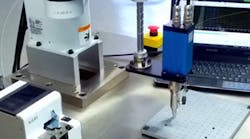Fastening can be a factory’s bottleneck, limiting the number of pieces completed. In fact, improving fastening speed can often be the most effective way to increase production and, in turn, revenue.
However, speed is no substitute for accuracy. If a production line’s rate of lost product increases at the same time as its overall speed does, then no ground is truly gained. For each extra piece assembled, another is lost to rework or the scrap pile. So, in order to actually improve assembly line production, fast, accurate fastening equipment is necessary.
Faster Assembly Line Production with Modern Fastening Equipment
Assembly lines producing large amounts of small, similar products most depend on high-speed manufacturing. These types of operations typically have high throughput rates and expect each tool to fasten a large number of pieces. In this sort of manufacturing, the speed of each tool directly relates to the pace of production.
The speed of a tool depends on several factors. First, it depends on the actual speed of the tool’s driver, its revolutions per minute. Tool speed also varies based on the tool’s rundown speed, which is how long it takes for the tool to return to its original position. The length of the screw or bolt can itself be a factor, with long fasteners requiring slightly more revolutions than smaller ones. Finally, consider the operator or controller—how long does it take them to position the tool, remove it, and reposition it?
These combined figures add up to the total time per fastener, which, when multiplied by the number of fasteners per piece, gives you your total time per piece. Given this figure, you can go comparison shopping for a suite of tools which can beat your rate. You’ll see the most significant gains when moving from hand to electric tools, but simply updating to newer models or higher quality electric tools can significantly increase production speed as well. Typically, electric screwdrivers are best suited for fast, light manufacturing due to their high speeds. Again, though, you will always need to keep accuracy in mind.
Accurate Tools Improve Assembly Line Product Loss Rate
Each fastener requires an ideal application of torque. Without enough torque holding it in place, a fastener can work free or fall out, especially under stress. Loose fasteners detected in quality assurance qualify a piece for rework; loose fasteners detected on the market may be grounds for recall.
Fasteners can be over-tightened as well, causing damage to themselves or the product. This damage can show up immediately or later when the product fails on the market. The right amount of torque for each fastener depends on the properties of the screw, its substrate materials, the assembly design, and the intended use. The correct values should be specified in a product’s designs.
In rapid production, other lapses in tool accuracy—such as cross-threading, omissions, or unfinished rundowns—can increase the production time or the lost product rate as well. Quality torque screwdrivers and automatic controllers are the best ways to maintain product accuracy. Torque screwdrivers sense how much torque has been applied to a fastener and stop fastening only when the right amount has been reached. Automatic controllers can detect fastening errors like omissions, cross-threads, and unfinished rundowns, thereby reducing delays.
Rapidity and repeatability are critical aspects of modern assembly line production. The more pieces your assembly line is able to complete in one quarter, the more orders you’ll be able to take in the next one. Cutting down on lost product and rework not only improves production volume but it increases feedstock efficiency as well. Modern electric torque control screwdrivers, managed by an automated control system, represent the height of light manufacturing efficiency and quality.










